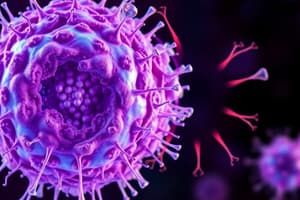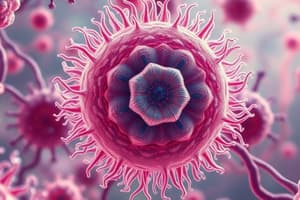Podcast
Questions and Answers
Which statement about prokaryotic cells is true?
Which statement about prokaryotic cells is true?
- They have a nucleus.
- They lack membrane-bound organelles. (correct)
- They are larger than eukaryotic cells.
- Their DNA is linear and organized into chromosomes.
Which of the following organelles is responsible for producing ATP?
Which of the following organelles is responsible for producing ATP?
- Golgi Apparatus
- Mitochondria (correct)
- Ribosomes
- Lysosomes
What is the primary function of the rough endoplasmic reticulum?
What is the primary function of the rough endoplasmic reticulum?
- Detoxification
- Energy production
- Lipid synthesis
- Protein synthesis (correct)
Which phase of mitosis is characterized by the separation of sister chromatids?
Which phase of mitosis is characterized by the separation of sister chromatids?
Which type of cell division results in gametes with half the number of chromosomes?
Which type of cell division results in gametes with half the number of chromosomes?
What role do lysosomes play in a cell?
What role do lysosomes play in a cell?
Which component of the cell membrane controls the movement of substances in and out?
Which component of the cell membrane controls the movement of substances in and out?
In what type of signaling do cells communicate with themselves?
In what type of signaling do cells communicate with themselves?
Flashcards are hidden until you start studying
Study Notes
Cell Biology
-
Cell Theory
- All living organisms are composed of cells.
- The cell is the basic unit of life.
- All cells arise from pre-existing cells.
-
Types of Cells
-
Prokaryotic Cells
- Lack a nucleus and membrane-bound organelles.
- DNA is circular and free-floating in the cytoplasm.
- Examples: Bacteria and Archaea.
-
Eukaryotic Cells
- Have a nucleus and membrane-bound organelles.
- DNA is linear and organized into chromosomes.
- Examples: Plant cells, animal cells, fungi, and protists.
-
-
Cell Structure
-
Cell Membrane
- Semi-permeable barrier that regulates the movement of substances in and out of the cell.
- Composed of a phospholipid bilayer with embedded proteins.
-
Cytoplasm
- Jelly-like substance where cellular processes occur.
- Contains organelles.
-
Nucleus
- Control center of the cell.
- Houses DNA and is surrounded by a nuclear membrane.
-
Organelles
- Mitochondria: Powerhouse of the cell; produces ATP through cellular respiration.
- Ribosomes: Sites of protein synthesis; can be free-floating or bound to the endoplasmic reticulum.
- Endoplasmic Reticulum (ER):
- Rough ER: Studded with ribosomes; synthesizes proteins.
- Smooth ER: Lacks ribosomes; synthesizes lipids and detoxifies.
- Golgi Apparatus: Modifies, sorts, and packages proteins and lipids for secretion or use within the cell.
- Lysosomes: Contain digestive enzymes; break down waste materials and cellular debris.
- Chloroplasts (in plant cells): Site of photosynthesis; contain chlorophyll.
-
-
Cell Division
-
Mitosis: Process of cell division resulting in two identical daughter cells.
- Phases: Prophase, Metaphase, Anaphase, Telophase.
-
Meiosis: Process of cell division that produces gametes (sperm and eggs) with half the number of chromosomes.
-
-
Cell Communication
- Cells communicate through signaling molecules and receptors.
- Types of signaling:
- Autocrine: Cell signals itself.
- Paracrine: Cell signals nearby cells.
- Endocrine: Signals sent through the bloodstream to distant cells.
-
Cell Metabolism
- Anabolism: Synthesis of complex molecules from simpler ones (requires energy).
- Catabolism: Breakdown of complex molecules into simpler ones (releases energy).
-
Cell Cycle Regulation
- Controlled by checkpoints (G1, S, G2, M phases).
- Cyclins and cyclin-dependent kinases (CDKs) regulate progression through the cell cycle.
-
Stem Cells
- Undifferentiated cells with the ability to develop into various cell types.
- Types:
- Embryonic stem cells: Can differentiate into any cell type.
- Adult stem cells: More limited in differentiation potential.
Cell Biology
- Cell Theory
- Comprises three fundamental principles about living organisms and cells.
- All organisms are made of cells, which are the basic units of life.
- Cells originate only from pre-existing cells.
Types of Cells
-
Prokaryotic Cells
- Characterized by the absence of a nucleus and membrane-bound organelles.
- DNA is circular and floats freely in the cytoplasm.
- Examples include Bacteria and Archaea.
-
Eukaryotic Cells
- Feature a nucleus and various membrane-bound organelles.
- DNA is linear and organized into chromosomes.
- Examples include plant cells, animal cells, fungi, and protists.
Cell Structure
-
Cell Membrane
- Acts as a semi-permeable barrier that regulates substance movement in and out of the cell.
- Composed of a phospholipid bilayer with embedded proteins.
-
Cytoplasm
- A jelly-like substance that facilitates cellular processes.
- Contains essential organelles for cell function.
-
Nucleus
- Serves as the control center of the cell.
- Houses DNA and is enveloped by a nuclear membrane.
-
Organelles
- Mitochondria: Known as the powerhouse of the cell; responsible for ATP production via cellular respiration.
- Ribosomes: Sites where protein synthesis occurs; may be free-floating or attached to the endoplasmic reticulum.
- Endoplasmic Reticulum (ER):
- Rough ER: Has ribosomes and synthesizes proteins.
- Smooth ER: Lacks ribosomes; synthesizes lipids and detoxifies substances.
- Golgi Apparatus: Modifies, sorts, and packages proteins and lipids for secretion or internal use.
- Lysosomes: Contain digestive enzymes that break down waste materials and cellular debris.
- Chloroplasts (found in plant cells): Sites of photosynthesis and contain chlorophyll.
Cell Division
-
Mitosis
- A process resulting in the division of one cell into two identical daughter cells.
- Involves distinct phases: Prophase, Metaphase, Anaphase, Telophase.
-
Meiosis
- A specialized division that produces gametes (sperm and eggs) with half the chromosome number.
Cell Communication
- Cells utilize signaling molecules and receptors to communicate.
- Types of signaling include:
- Autocrine: Cell signals itself.
- Paracrine: Cell signals adjacent cells.
- Endocrine: Signaling molecules reach distant cells via bloodstream.
Cell Metabolism
- Anabolism: The process of energy-requiring synthesis of complex molecules from simpler ones.
- Catabolism: The breakdown of complex molecules into simpler ones, releasing energy.
Cell Cycle Regulation
- Progression through the cell cycle is tightly controlled by checkpoints (G1, S, G2, M phases).
- Cyclins and cyclin-dependent kinases (CDKs) are key regulators of the cell cycle.
Stem Cells
- Undifferentiated cells that have the potential to develop into various cell types.
- Types of stem cells vary in differentiation capability:
- Embryonic stem cells: Can differentiate into any cell type.
- Adult stem cells: Have a more limited capacity for differentiation.
Studying That Suits You
Use AI to generate personalized quizzes and flashcards to suit your learning preferences.




